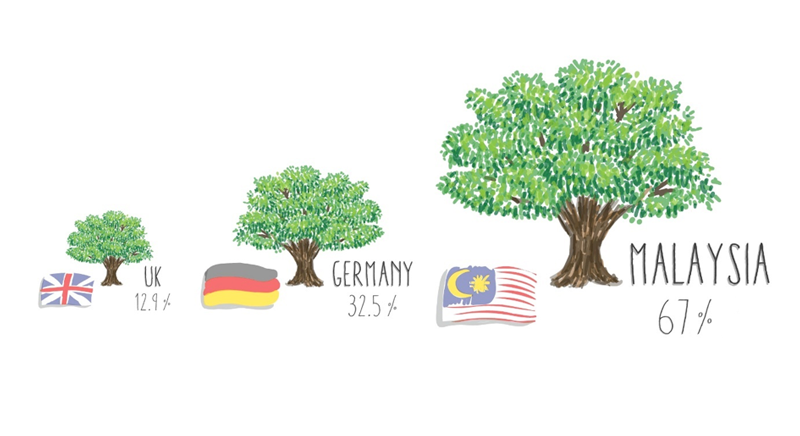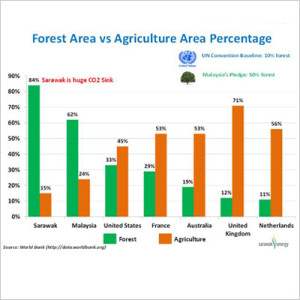Real-time Eco-credentials of Palm Oil
Everyone who follows the news would have heard of the alleged connection being made between the production of palm oil and global warming. Slash and burn agriculture, the destruction of peatlands and vast monoculture plantations are said to emit unprecedented amounts of greenhouse gases (GHG) into the atmosphere, effectively killing the planet.
Without denying that problems do exist, it is time for a more balanced look at these issues. In particular, the reality on the ground in Malaysia is quite different.
The traditional argument by environmental groups basically runs like this: large areas of the rainforest are destroyed and turned into oil palm plantations. Massive amounts of carbon stocked in the forests are released, contributing to global warming.
It may come as a surprise to many that Malaysia, after decades of brisk economic growth, is ranked in the top 20 countries in terms of tree cover. Excluding land under production, a whopping 67% of the Malaysian land area is covered with trees, according to World Bank data.[1]
As Figure 1 shows, this compares very favourably with Western European countries. Also noteworthy is the fact that Malaysia has dedicated more than 15% of its territory to protected forest. That is more than five million hectares in total.[2]
The World Bank further confirms that Malaysia´s forest cover has increased in the past few years, albeit not by much.
Figure 1: Comparison of tree cover
Source: MPOC, 2015
In truth, this should not even be such a big surprise. After all, Malaysia had committed almost 25 years ago at the 1992 Rio Earth Summit to maintaining a minimum forest cover of 50%. That goal was reiterated at the United Nations Framework Convention on Climate Change (UNFCC) in Copenhagen in 2009. Indeed, the country has ‘over-delivered’ on that promise.
Biogas production
Does that mean that there is no issue with GHG emissions in palm oil production? No, such a claim would be outlandish. As with every other economic activity, the production of palm oil also produces emissions. It is a subject that has to be dealt with responsibly.
The problem lies not primarily with deforestation or land conversion, as most people believe. According to a study by the largest international certification body for sustainable palm oil, the Roundtable on Sustainable Palm Oil (RSPO), the biggest issue is what is called palm oil mill effluent (POME).
In the production of crude palm oil, fresh fruit bunches are ground to extract the oil. POME is a by-product of the milling process and contains a high concentration of biodegradable organic material.
This makes it necessary to treat POME before it can be discharged. Usually, POME is collected in ponds or lagoons and naturally available oxygen takes care of the disintegration of the organic material.
The problem is that the decomposition releases biogas, mainly methane, which is considered a potent GHG. From the POME ponds, it finds its way into the atmosphere.
Technology to trap biogas
But here is the good news: the technology to control biogas exists and is already at work in Malaysia. The key is to capture the biogas during the production process.
The Malaysian government has recognised this solution as an opportunity. In its national Economic Transformation Plan, 12 National Key Economic Areas have been established, with palm oil being one of them. For this sector, eight key measures or Entry Point Projects (EPP) are defined.
EPP No. 5 is: ‘Build biogas facilities at mills across Malaysia’. The declared goal [3] of the programme is to:
- encourage palm oil mills in Malaysia to implement biogas trapping and utilisation; and
- inform palm oil millers about the benefits of biogas trapping, and provide the relevant information to facilitate planning and implementation.
If the biogas is captured in the process of producing crude palm oil, a win-win situation emerges, mainly for two reasons.
First, the benefits to the producers themselves are two-fold. On one hand, they can save costs by using the biogas as fuel in the mills, replacing diesel.
Also, plantations may earn emission certificates under the Clean Development Mechanism of the Kyoto Protocol (the part of the UNFCC that commits the participating countries to GHG emissions savings targets). Those certificates are potential money earners because they are internationally tradeable.
Secondly, the climate stands to benefit. Not only is the methane not released into the atmosphere, but the replacement of diesel also means the production of less GHG.
The overall effect on the climate can be so significant that the RSPO even concludes:
‘If new production areas are developed in areas which are not high in carbon stocks, palm oil production may lead to net carbon sequestration.’[4]
Climate-protection potential
Many will find this conclusion to be counter-intuitive. Consumers are so used to thinking about the alleged environmental damage attributed to palm oil that they forget one simple, but vital fact: the oil palm is a tree. As everybody knows, trees store carbon dioxide.
Add to that the potential of palm-based biofuel to replace the limited resources of fossil fuels like petroleum, and the environmental picture painted by palm oil looks decidedly sunnier.
It is important to recognise that blanket statements like ‘palm oil destroys the climate’ are fallacious. They lump diverse aspects of a complex topic together, blinding the observer from seeing relationships that matter.
If done right, palm oil production, instead of destroying the environment, may actually save it. This is because when it comes to the effects on climate change, the comparison should not be ‘palm oil production vs no palm oil production’. Instead it should be ‘palm oil production vs other vegetable oil production’.
The reason is that, from all the vegetable oils that can be produced in sufficient quantity, palm oil is by far the most productive crop looking at yield per hectare of land. Some studies show that regarding the impact on the climate, the oil palm is equal to the other big oil crop, soybean. But given its much better productivity, the oil palm easily outperforms soybean overall.
At the end of the day the reality is this: a large and growing global demand exists for vegetable oil. Based on purely technical reasons, it is unlikely that any crop other than the oil palm can satisfy this need.
So what is needed is a responsible, environmentally sustainable supply chain from ‘cradle to grave’. Malaysia has come a long way in making its palm oil greener. So the conclusion seems inescapable: when it comes to being sensible about climate change, Malaysian palm oil is second to none.
[1] Available at: http://data.worldbank.org
[2] Vergano, P and Ignacio Carreno, Uses and Potential Abuses of ´Negative Claims`, in The European Journal of Risk Regulation, 4/2014, p 13
[3] National Biogas Implementation, available online at: http://www.mpob.gov.my/images/stories/pdf/2014/2014_nkea.pdf
[4] Greenhouse Gas Emissions from Palm Oil Production Literature review and proposals from the RSPO Working Group on Greenhouse Gases Final Report, 9 October 2009, p 26; available online at: http://www.rspo.org/files/project/GreenHouse.Gas.Working.Group/Report-GHG-October2009.pdf











Leave a Reply